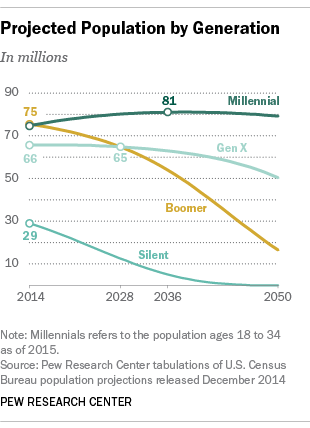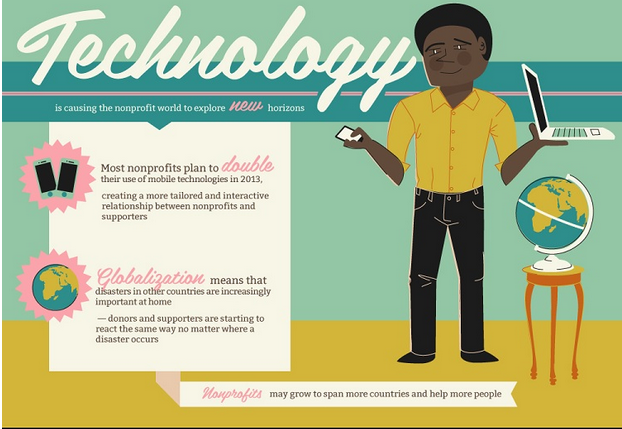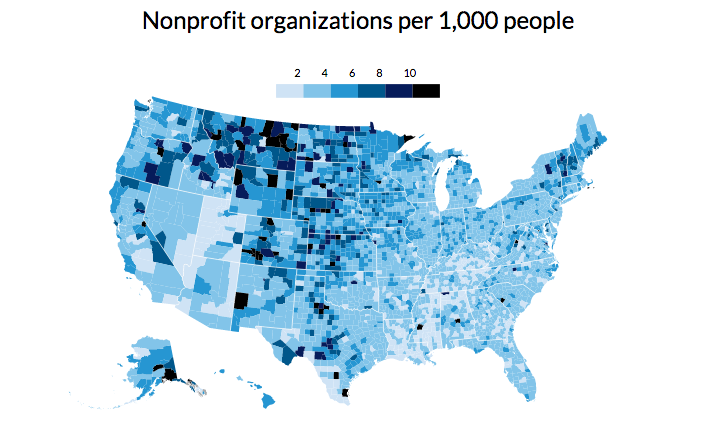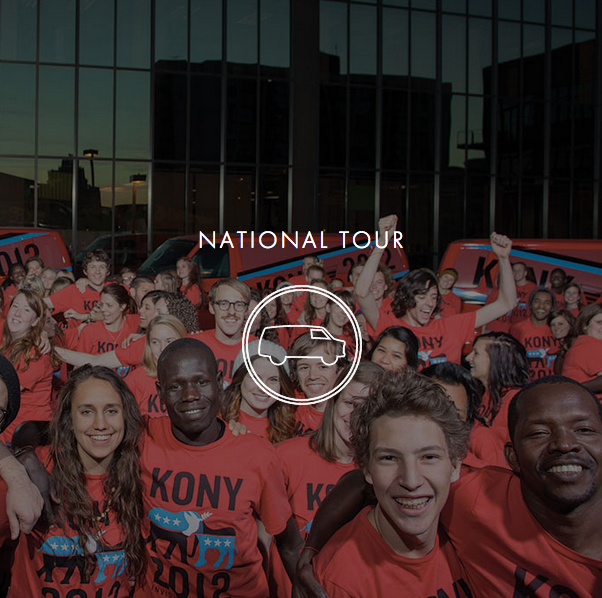fundraising
Millennials and Multimedia: Fundraising in the Digital Age
This post originally appeared on the ScaleFunder blog.
 The Shift
The Shift
We are on the dawn of a major shift in the fundraising industry. As the loyal donor base of the baby boomer generation continues to decline, the millennial generation is steadily coming to take their place. According to the Pew Research Center, there will be 81 million people who are a part of the millennial generation in the United States, compared to only 51 million baby boomers by 2036.1
But these 81 million grew up conditioned by Amazon’s one-click world of choice and the constant connectivity of Facebook. They follow the progress of their online purchases through FedEx and UPS until it’s at their door. Even Domino’s tells them when their pizza is being tossed and when it’s baking in the oven. If trust is lost (or your pizza), they take to Twitter and let the world know. The power of once voice can impact thousands in the new digital age.

It’s no surprise that these conditions have permeated the non-profit market. With 3 million new non-profit organizations born from 2001-2011 (3), the millennial generation has the unique ability to find the exact charitable cause that fits their passions as a donor. With all of these extra choices, they are now doing their research on the impact of each cause and expect to be shown the impact of a gift quickly and expect feedback at any gift amount.
As fundraisers, this paradigm shift completely changes our game. With real-time data in virtually every other market, gone are the days where your annual report to donors is often enough or transparent enough to be satisfactory. We are jumping into an era where transparency builds trust and trust breeds loyalty. So how do we scale personal connection to the masses and cultivate our new donor base?

The Crowded Market
The millennial generation is entering the U.S. market of philanthropy with 1.6 million registered non-profit organizations4 and easy access to information about each one. These circumstances have prompted 61% of donors between the ages of 20-35 to give smaller donations to between 3-5 different organizations, rather than a large gift to one.5 And in 2013, the response rate to mass fundraising e-mails was 0.07%, down 11% from 2012.6 Yet in business marketing for Internet retailers, potential consumers who viewed the product video converted at a 400% increase over those who did not7 and one out of four business marketers are using video in email campaigns.8. Business marketing has built its home and settled in to our increasingly online world, living in the new consumer’s neighborhood. So let’s move in, creating narratives that bring our organizational family to life through multimedia. We need to live side-by-side the millennial generation or risk losing them to the other 1.6 million houses on the street.

The New Non-Profit
Who are these new non-profit upstarts that have entered the market? How did they come to compete with historical powerhouse charitable institutions with multiple entrenched causes? Yet again, our answer lies in the new paradigm that promotes unique needs and specific missions. Do you want to give to an organization that focuses on decreasing lead levels in housing so it doesn’t impact children’s health? There’s an organization for that. Do you want to give to an organization that focuses on research for Fragile X Syndrome? There’s an organization for that. Do you want to give to an organization that plants flowers on football fields to create a balanced atmosphere of peace and tranquility among men in helmets crashing into each other? Well…there isn’t an organization for that…yet. But these millennial donors want to see their dollars make an impact. The easiest way to do that is to find an organization that supports your unique interests and give. In a world with an abundance of choice, that ability is more attainable than ever.
If we want to be competitive in the market of niche non-profits, we have to be transparent about our mission, even with funds that champion a myriad of different services throughout the institution. In higher
education, the causes our annual programs and unrestricted funds support have faces. And names. And history. Unpack those pieces in different multimedia channels and match them to your donors that fall within each affinity. We can no longer afford to use the big tent approach in a world that focuses on the importance of each pole in its structure.
The Rise of Video
In 2005, YouTube began a video revolution. This medium has turned artists like Justin Bieber and the band 5 Seconds of Summer into pop stars and allowed real-life footage of world change like the Arab Spring into the homes of millions across the world. The user-generated authenticity of these videos struck a chord into the soul of society and as of 2013, YouTube users were watching 4 billion hours of video each month and uploading 72 hours of video every minute.10 Compounding on this trend, apps like Snapchat, Instagram, and Vine emerged, all that were solely focused on or included short video clip capability. Facebook even puts a premium on video when it came to boosting posts of Organization pages.11 The power of user-generated content to deliver your message is perfectly implemented in this 2012 Target commercial:12
A brilliant commercial of reactions from young people being accepted to college was a thirty-second story about you and me, while promoting Target’s philanthropic support of K-12 schools. User-generated content allows you to empower your volunteers while simultaneously gaining trust with their audiences and showing personalized impact of funds raised.
Case Study: Invisible Children

The power of video is represented no better than in the inception and life of the non-profit Invisible Children. From three friends and a documentary that brought to light the practice of abducting children to be soldiers in Uganda, an organization was born in 2003. This spun into a multi-million dollar advocacy and program based non-profit that made 12 films and 532 program/campaign videos, generating 134,738,170 views of their online video content.14 By 2011, they were receiving 5.7 million dollars in donations, excluding grants and partnerships.15. Through the KONY 2012 campaign, they raised 5.7 million dollars in three and a half months.16 At that time, 65% of their base was between the ages of 18-25.17 Their videos showcased the problem they were trying to solve straight from the streets of Uganda, highlighted the impact of their programs, and translated multimedia into millions of dollars.
“I don’t believe it’s an understatement to call Invisible Children
the most millennial led movement to date”.– Guy Raz, Host of NPR’s TED Radio Hour18

Video is the medium of the millennial generation.
Conclusion
We are at a critical point in our industry where best practices for millennial donors need to be codified and implemented across the board in order to sustain the life-changing work that our organizations do. So where do we start?
What We Know
- We need to live side-by-side the millennial generation or risk losing them to the other 1.6 million houses on the street.
- We can no longer afford to use the big tent approach in a world that focuses on the importance of each pole in its structure.
- User-generated content allows you to empower your volunteers while simultaneously gaining trust with their audiences and showing personalized impact of funds raised.
- Video is the medium of the millennial generation.
Where We’re Moving
The high-touch, low-cost mechanism of video is crucial to unlocking trust and opening the door to millennials. Video scales the personal relationship to a large community, putting a face on every ask, and making impact real at any gift size to a group that just wants to know they are making a difference.
A multimedia approach to fundraising is just one move towards adapting to our changing donor base and we’d love to hear how you’re tackling engagement in the 21st century!
Sources
- 1 and 2. Fry, Richard. “This Year, Millennials Will Overtake Baby Boomers.” Pew Research Center RSS. Pew Research Center, 16 Jan. 2015. Web. 23 Feb. 2015.
- 3. Roeger, Katie L., Amy S. Blackwood, and Sarah L. Pettijohn. “The Nonprofit Almanac.” The Urban Institute. Urban Institute Press, 31 Oct. 2012. Web. 23 Feb. 2015.
- 4. Lambert, Jaclyn. “Infographic: What Is Driving Nonprofit Sector’s Growth?” Nonprofit Quarterly. Nonprofit Quarterly, 10 Dec. 2013. Web. 23 Feb. 2015.
- 5. Johnson, Grossnickle, Associates. “Millennial Donor Report 2011.” Trusted Partner. Achieve Johnson, Grossnickle & Associates, 1 Jan. 2011. Web. 23 Feb. 2015.
- 6. Lefevre, Cameron, Will Valverde, and Sarah Vanderbilt. “Benchmarks 2014.” M and R (2014): 56. Print.
- 7. “Invodo Video Statistics – Internet Retailer.” Invodo. Invodo, 1 Jan. 2009. Web. 23 Feb. 2015.
- 8. “Invodo Video Statistics – EMarketer.” Invodo. Invodo, 1 Jan. 2013. Web. 23 Feb. 2015.
- 9. Roeger, Katie L., Amy S. Blackwood, and Sarah L. Pettijohn. “The Nonprofit Almanac.” The Urban Institute. Urban Institute Press, 31 Oct. 2012. Web. 23 Feb. 2015.
- 10. Dickey, Megan. “The 22 Key Turning Points In The History Of YouTube.” Business Insider. Business Insider, Inc, 15 Feb. 2013. Web. 23 Feb. 2015.
- 11. Business, Facebook for. “New Ways for Marketers to Build Their Brands on Facebook.” Facebook for Business. Facebook, 5 June 2014. Web. 26 Feb. 2015.
- 12. “Target TV Commercial, ‘Scholarships'” ISpot.tv. Deutsch Agency, 27 July 2012. Web. 24 Feb. 2015.
- 13, 14 and 19. “Invisible Children | Past Programs – Film.” Invisible Children. Invisible Children, 1 Jan. 2014. Web. 23 Feb. 2015.
- 15. “2011 Invisible Children Annual Report.” Invisible Children. Invisible Children, 1 Jan. 2012. Web. 23 Feb. 2015.
- 16. “2012 Invisible Children Annual Report.” Invisible Children. Invisible Children, 1 Jan. 2013. Web. 23 Feb. 2015.
- 17. Karlin, Beth. “Educating, Empowering & Engaging Through Film-Based Activism: A Survey of Invisible Children Participation and Impacts.” Center for Unconventional Security Affairs, UC Irvine (2012): 31. EScholarship University of Southern California. EScholarship University of California. Web. 23 Feb. 2015.
- 18. Raz, Guy. “InsideNGO Annual Conference Keynote.” InsideNGO Annual Conference. InsideNGO. , Washington, D.C.. 30 July 2014. Lecture.